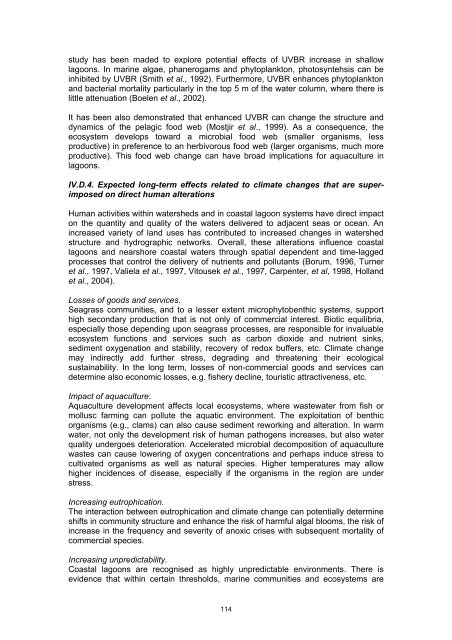Climate Change and the European Water Dimension - Agri ...
Climate Change and the European Water Dimension - Agri ...
Climate Change and the European Water Dimension - Agri ...
You also want an ePaper? Increase the reach of your titles
YUMPU automatically turns print PDFs into web optimized ePapers that Google loves.
study has been maded to explore potential effects of UVBR increase in shallow<br />
lagoons. In marine algae, phanerogams <strong>and</strong> phytoplankton, photosyntehsis can be<br />
inhibited by UVBR (Smith et al., 1992). Fur<strong>the</strong>rmore, UVBR enhances phytoplankton<br />
<strong>and</strong> bacterial mortality particularly in <strong>the</strong> top 5 m of <strong>the</strong> water column, where <strong>the</strong>re is<br />
little attenuation (Boelen et al., 2002).<br />
It has been also demonstrated that enhanced UVBR can change <strong>the</strong> structure <strong>and</strong><br />
dynamics of <strong>the</strong> pelagic food web (Mostjir et al., 1999). As a consequence, <strong>the</strong><br />
ecosystem develops toward a microbial food web (smaller organisms, less<br />
productive) in preference to an herbivorous food web (larger organisms, much more<br />
productive). This food web change can have broad implications for aquaculture in<br />
lagoons.<br />
IV.D.4. Expected long-term effects related to climate changes that are superimposed<br />
on direct human alterations<br />
Human activities within watersheds <strong>and</strong> in coastal lagoon systems have direct impact<br />
on <strong>the</strong> quantity <strong>and</strong> quality of <strong>the</strong> waters delivered to adjacent seas or ocean. An<br />
increased variety of l<strong>and</strong> uses has contributed to increased changes in watershed<br />
structure <strong>and</strong> hydrographic networks. Overall, <strong>the</strong>se alterations influence coastal<br />
lagoons <strong>and</strong> nearshore coastal waters through spatial dependent <strong>and</strong> time-lagged<br />
processes that control <strong>the</strong> delivery of nutrients <strong>and</strong> pollutants (Borum, 1996, Turner<br />
et al., 1997, Valiela et al., 1997, Vitousek et al., 1997, Carpenter, et al, 1998, Holl<strong>and</strong><br />
et al., 2004).<br />
Losses of goods <strong>and</strong> services.<br />
Seagrass communities, <strong>and</strong> to a lesser extent microphytobenthic systems, support<br />
high secondary production that is not only of commercial interest. Biotic equilibria,<br />
especially those depending upon seagrass processes, are responsible for invaluable<br />
ecosystem functions <strong>and</strong> services such as carbon dioxide <strong>and</strong> nutrient sinks,<br />
sediment oxygenation <strong>and</strong> stability, recovery of redox buffers, etc. <strong>Climate</strong> change<br />
may indirectly add fur<strong>the</strong>r stress, degrading <strong>and</strong> threatening <strong>the</strong>ir ecological<br />
sustainability. In <strong>the</strong> long term, losses of non-commercial goods <strong>and</strong> services can<br />
determine also economic losses, e.g. fishery decline, touristic attractiveness, etc.<br />
Impact of aquaculture:<br />
Aquaculture development affects local ecosystems, where wastewater from fish or<br />
mollusc farming can pollute <strong>the</strong> aquatic environment. The exploitation of benthic<br />
organisms (e.g., clams) can also cause sediment reworking <strong>and</strong> alteration. In warm<br />
water, not only <strong>the</strong> development risk of human pathogens increases, but also water<br />
quality undergoes deterioration. Accelerated microbial decomposition of aquaculture<br />
wastes can cause lowering of oxygen concentrations <strong>and</strong> perhaps induce stress to<br />
cultivated organisms as well as natural species. Higher temperatures may allow<br />
higher incidences of disease, especially if <strong>the</strong> organisms in <strong>the</strong> region are under<br />
stress.<br />
Increasing eutrophication.<br />
The interaction between eutrophication <strong>and</strong> climate change can potentially determine<br />
shifts in community structure <strong>and</strong> enhance <strong>the</strong> risk of harmful algal blooms, <strong>the</strong> risk of<br />
increase in <strong>the</strong> frequency <strong>and</strong> severity of anoxic crises with subsequent mortality of<br />
commercial species.<br />
Increasing unpredictability.<br />
Coastal lagoons are recognised as highly unpredictable environments. There is<br />
evidence that within certain thresholds, marine communities <strong>and</strong> ecosystems are<br />
114













